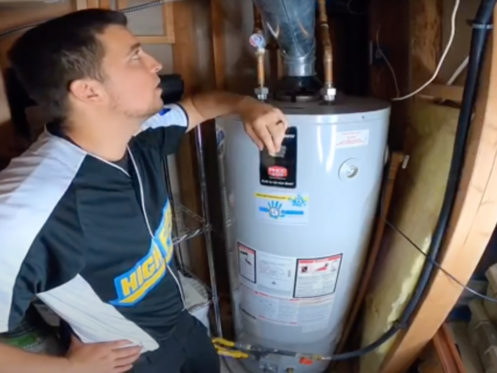What are your opinions about Tips on Maintaining a Water Heater?

Hot water is vital for everyday convenience, whether it's for a revitalizing shower or washing meals. To ensure your hot water system runs effectively and lasts much longer, routine maintenance is essential. This post supplies functional ideas and understandings on how to maintain your home's warm water system to stay clear of disturbances and pricey fixings.
Intro
Preserving your home's warm water system may appear complicated, however with a few simple steps, you can guarantee it runs efficiently for many years to come. This overview covers every little thing from comprehending your hot water system to DIY maintenance pointers and recognizing when to employ expert aid.
Relevance of Keeping Your Hot Water System
Regular maintenance not just prolongs the life expectancy of your hot water system yet also ensures it runs effectively. Overlooking maintenance can bring about reduced effectiveness, greater energy costs, and even premature failing of the system.
Signs Your Warm Water System Demands Maintenance
Knowing when your warm water system needs attention can protect against significant issues. Keep an eye out for indications such as inconsistent water temperature level, strange sounds from the heating unit, or rusty water.
Purging the Water Heater
Purging your hot water heater removes debris accumulation, boosting effectiveness and lengthening its life.
Monitoring and Replacing Anode Rods
Anode poles avoid deterioration inside the tank. Evaluating and replacing them when broken is vital.
Complex Problems Requiring Specialist Help
Instances include significant leaks, electric problems, or if your water heater is continually underperforming.
Routine Specialist Maintenance Perks
Professional upkeep can include complete inspections, tune-ups, and making sure compliance with security standards.
Examining and Readjusting Temperature Setups
Adjusting the temperature level setups guarantees optimum performance and security.
Do It Yourself Tips for Maintenance
You can execute several maintenance jobs yourself to maintain your warm water system in top problem.
Looking for Leaks
On a regular basis check pipes and connections for leakages, as these can bring about water damage and greater costs.
Recognizing Your Warm Water System
Prior to diving into maintenance jobs, it's handy to understand the fundamental parts of your hot water system. Usually, this consists of the hot water heater itself, pipes, anode rods, and temperature level controls.
Month-to-month Upkeep Tasks
Routine regular monthly checks can aid capture small concerns prior to they rise.
Examining Stress Alleviation Valves
Examining the stress safety valve guarantees it functions correctly and avoids extreme stress build-up.
Insulating Pipelines
Shielding warm water pipelines minimizes warm loss and can conserve power.
When to Call an Expert
While DIY maintenance is advantageous, some problems require professional proficiency.
Conclusion
Normal upkeep of your home's warm water system is necessary for effectiveness, durability, and cost savings. By adhering to these pointers and recognizing when to look for expert help, you can ensure a reliable supply of warm water without unanticipated interruptions.
How to Maintain an Instant Hot Water Heater
Before tinkering with your hot water heater, make sure that it’s not powered on. You also have to turn off the main circuit breaker and shut off the main gas line to prevent accidents. Also turn off the water valves connected to your unit to prevent water from flowing into and out of the appliance. 2. When you’re done, you have to detach the purge valves’ caps. These look like the letter “T†and are situated on either side of the water valves. Doing so will release any pressure that has accumulated inside the valves while at the same time avoid hot water from shooting out and burning your skin. 3. When the purge valves’ caps are removed, you have to connect your hosing lines to the valves. Your unit should have come with three hoses but if it didn’t, you can purchase these things from any hardware or home repair shops. You can also get them from retail stores that sell water heating systems. Read the user’s manual and follow it to complete this task properly. When the hosing lines are connected, open the purge port’s valves. 4. You should never use harsh chemical cleaners or solutions when cleaning your unit. Make use of white vinegar instead. It should be undiluted and you’ll probably use about 2 gallons. 5. Now flush your water heater. This task should probably take about 40 minutes. We can’t give you specific directions for this because the procedure is carried out depending on the type, model and brand of your heater. With that being said, refer to the user’s manual. 6. When you’re done draining the unit, you have to turn off the purge port valves again. Remove the hosing lines that you earlier installed on each of the water valves. Put the valve caps (purge port) back in their respective places and be very careful so as not to damage the rubber discs that are found inside these caps. 7. Now that everything’s back in place, check your user’s manual again to find out how to reactivate your water heating system. 8. Once it is working, turn one of your hot water faucets on just to let air pass through the heater’s water supply pipes. Leave the tap on until water flows smoothly out of it. https://www.orrplumbing.com/blog/2014/september/how-to-maintain-an-instant-hot-water-heater/

Do you appreciate reading about Tips on Maintaining a Water Heater? Place feedback down the page. We will be glad to hear your reactions about this page. We are looking forward that you visit us again in the future. Sharing is good. Helping people is fun. I praise you for being here. Kindly check our website back soon.
Click Here